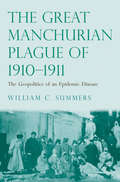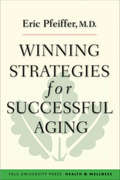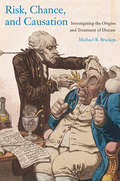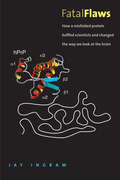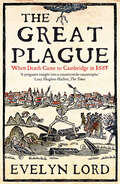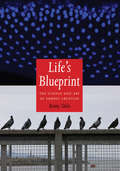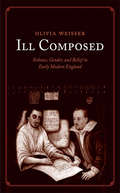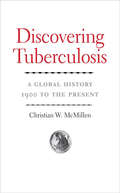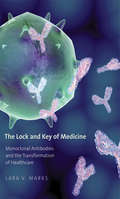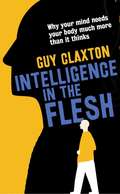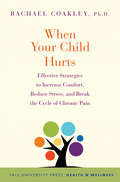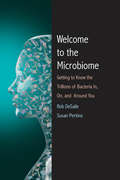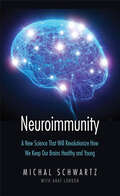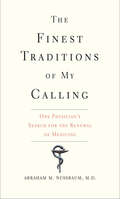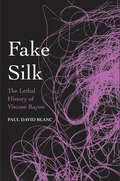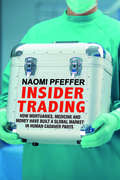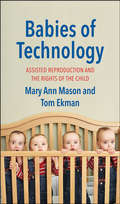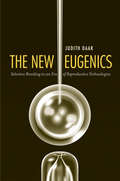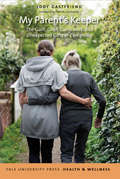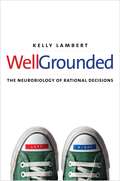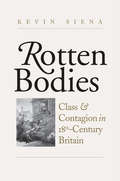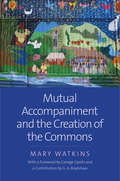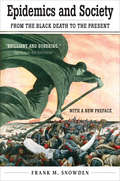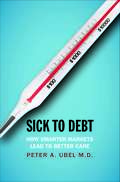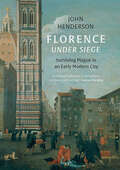- Table View
- List View
The Great Manchurian Plague of 1910-1911: The Geopolitics of an Epidemic Disease
by Dr. William C. SummersWhen plague broke out in Manchuria in 1910 as a result of transmission from marmots to humans, it struck a region struggling with the introduction of Western medicine, as well as with the interactions of three different national powers: Chinese, Japanese, and Russian. In this fascinating case history, William Summers relates how this plague killed as many as 60,000 people in less than a year, and uses the analysis to examine the actions and interactions of the multinational doctors, politicians, and ordinary residents who responded to it.Summers covers the complex political and economic background of early twentieth-century Manchuria and then moves on to the plague itself, addressing the various contested stories of the plague’s origins, development, and ecological ties. Ultimately, Summers shows how, because of Manchuria’s importance to the world powers of its day, the plague brought together resources, knowledge, and people in ways that enacted in miniature the triumphs and challenges of transnational medical projects such as the World Health Organization.
Winning Strategies for Successful Aging
by Eric PfeifferFor anyone who is approaching a 65th birthday with trepidation, this valuable book offers heartening advice on navigating the later years of life. Dr. Eric Pfeiffer, who for thirty years has cared for—and learned from—elderly people, addresses with compassion and deep understanding the multitude of issues that arise for aging individuals and their families. He writes authoritatively but in a conversational tone. His advice is easy to read, easy to follow, and full of wisdom.In short, practical chapters, Dr. Pfeiffer advises on choosing an ideal place to live, finding a range of satisfying activities, and maintaining an active social life. He also explains how best to maintain one's health, mental health, wealth, and independence. Other chapters explore the importance of a spiritual life and the value of maintaining an active sexual life. In addition, the author speaks to the value of charitable giving and describes how it is possible to prepare for a good good-bye to life. Filled with illustrative anecdotes and enhanced with a lovely selection of poems, this reassuring book demonstrates how it is possible to direct and control the aging experience. For every person approaching retirement years, and for their friends and families, the book is an excellent resource and a practical guide.
Risk, Chance, and Causation: Investigating the Origins and Treatment of Disease
by Michael B. BrackenThe press and other media constantly report news stories about dangerous chemicals in the environment, miracle cures, the safety of therapeutic treatments, and potential cancer-causing agents. But what exactly is actually meant by “increased risk”—should we worry if we are told that we are at twice the risk of developing an illness? And how do we interpret “reduced risk” to properly assess the benefits of noisily touted dietary supplements? Demonstrating the difficulty of separating the hype from the hypothesis, noted epidemiologist Michael Bracken clearly communicates how clinical epidemiology works. Using everyday terms, Bracken describes how professional scientists approach questions of disease causation and therapeutic efficacy to provide readers with the tools to help them understand whether warnings of environmental risk are truly warranted, or if claims of therapeutic benefit are justified.
Fatal Flaws: How a Misfolded Protein Baffled Scientists and Changed the Way We Look at the Brain
by Jay IngramDiscovered and identified as the cause of mad cow disease only three decades ago, the prion is a protein molecule that, when misshapen in the brain, becomes fatal. Novel and controversial, prions have provoked a scientific revolution. They challenge the very foundations of biology: A disease-causing entity with no genetic material at all? A molecule capable of infecting, multiplying, and killing? This book recounts the birth of prion science and the imaginative detective work scientists have undertaken as they struggle to find the answers to devastating brain diseases from mad cow and Creutzfeldt-Jakob disease to Parkinson’s, Alzheimer’s, Lou Gehrig’s, and others. As in each of his best-selling books, Jay Ingram here makes complex scientific concepts accessible and shows how little-known events may have profound significance. He describes the development of prion science as a rough-and-tumble affair, with rivals, eccentrics, interfering governments, and brilliantly creative people all playing salient roles. Weaving biology, medicine, human tragedy, discovery, and bitter scientific competition into his account, he reveals the stunning potential of prion science, whose discoveries may unlock the answers to some of humankind’s most destructive diseases.
The Great Plague: A People's History
by Evelyn LordIn this intimate history of the extraordinary Black Plague pandemic that swept through the British Isles in 1665, Evelyn Lord focuses on the plague’s effects on smaller towns, where every death was a singular blow affecting the entire community. Lord’s fascinating reconstruction of life during plague times presents the personal experiences of a wide range of individuals, from historical notables Samuel Pepys and Isaac Newton to common folk who tilled the land and ran the shops. She brings this dark era to vivid life through stories of loss and survival from those who grieved, those who fled, and those who hid to await their fate.
Life's Blueprint: The Science and Art of Embryo Creation
by Benny ShiloIn the span of just three decades, scientific understanding of the formation of embryos has undergone a major revolution. The implications of these new research findings have an immediate bearing on human health and future therapies, yet most nonscientists remain quite unaware of the exciting news. In this engaging book, a distinguished geneticist offers a clear, jargon-free overview of the field of developmental biology. Benny Shilo transforms complicated scientific paradigms into understandable ideas, employing an array of photographic images to demonstrate analogies between the cells of an embryo and human society. Shilo’s innovative approach highlights important concepts in a way that will be intuitive and resonant with readers’ own experiences. The author explains what is now known about the mechanisms of embryonic development and the commanding role of genes. For each paradigm under discussion, he provides both a scientific image and a photograph he has taken in the human world. These pairs of images imply powerful metaphors, such as the similarities between communication among cells and among human beings, or between rules embedded in the genome and laws that govern human society. The book concludes with a glimpse of promising future possibilities, including the generation of tissues and organs for use as “spare parts.”
Ill Composed: Sickness, Gender, and Belief in Early Modern England
by Prof. Olivia WeisserIn the first in-depth study of how gender determined perceptions and experiences of illness in seventeenth- and eighteenth-century England, Olivia Weisser invites readers into the lives and imaginations of ordinary men and women. Drawing on a wide range of sources, including personal diaries, medical texts, and devotional literature, the author enters the sickrooms of a diverse sampling of early modern Britons. The resulting stories of sickness reveal how men and women of the era viewed and managed their health both similarly and differently, as well as the ways prevailing religious practices, medical knowledge, writing conventions, and everyday life created and supported those varying perceptions. A unique cultural history of illness, Weisser’s groundbreaking study bridges the fields of patient history and gender history. Based on the detailed examination of over fifty firsthand accounts, this fascinating volume offers unprecedented insight into what it was like to live, suffer, and inhabit a body more than three centuries ago.
Discovering Tuberculosis: A Global History, 1900 to the Present
by Christian W. McMillenTuberculosis is one of the world’s deadliest infectious diseases, killing nearly two million people every year—more now than at any other time in history. While the developed world has nearly forgotten about TB, it continues to wreak havoc across much of the globe. In this interdisciplinary study of global efforts to control TB, Christian McMillen examines the disease’s remarkable staying power by offering a probing look at key locations, developments, ideas, and medical successes and failures since 1900. He explores TB and race in east Africa, in South Africa, and on Native American reservations in the first half of the twentieth century, investigates the unsuccessful search for a vaccine, uncovers the origins of drug-resistant tuberculosis in Kenya and elsewhere in the decades following World War II, and details the tragic story of the resurgence of TB in the era of HIV/AIDS. Discovering Tuberculosis explains why controlling TB has been, and continues to be, so difficult.
The Lock and Key of Medicine: Monoclonal Antibodies and the Transformation of Healthcare
by Lara V. MarksThis book is the first to tell the extraordinary yet unheralded history of monoclonal antibodies. Often referred to as Mabs, they are unfamiliar to most nonscientists, yet these microscopic protein molecules are everywhere, quietly shaping our lives and healthcare. Discovered in the mid-1970s in the laboratory where Watson and Crick had earlier unveiled the structure of DNA, Mabs have radically changed understandings of the pathways of disease. They have enabled faster, cheaper, and more accurate clinical diagnostic testing on a vast scale. And they have played a fundamental role in pharmaceutical innovation, leading to such developments as recombinant interferon and insulin, and personalized drug therapies such as Herceptin. Today Mabs constitute six of the world’s top ten blockbuster drugs and make up a third of new introduced treatments. Lara V. Marks recounts the risks and opposition that a daring handful of individuals faced while discovering and developing Mabs, and she addresses the related scientific, medical, technological, business, and social challenges that arose. She offers a saga of entrepreneurs whose persistence and creativity ultimately changed the healthcare landscape and brought untold relief to millions of patients. Even so, as Marks shows, controversies over Mabs remain, and she examines current debates over the costs and effectiveness of these innovative drugs.
Intelligence in the Flesh: Why Your Mind Needs Your Body Much More Than It Thinks
by Guy ClaxtonIf you think that intelligence emanates from the mind and that reasoning necessitates the suppression of emotion, you’d better think again—or rather not “think” at all. In his provocative new book, Guy Claxton draws on the latest findings in neuroscience and psychology to reveal how our bodies—long dismissed as mere conveyances—actually constitute the core of our intelligent life. From the endocrinal means by which our organs communicate to the instantaneous decision-making prompted by external phenomena, our bodies are able to perform intelligent computations that we either overlook or wrongly attribute to our brains. Embodied intelligence is one of the most exciting areas in contemporary philosophy and neuropsychology, and Claxton shows how the privilege given to cerebral thinking has taken a toll on modern society, resulting in too much screen time, the diminishment of skilled craftsmanship, and an overvaluing of white-collar over blue-collar labor. Discussing techniques that will help us reconnect with our bodies, Claxton shows how an appreciation of the body’s intelligence will enrich all our lives.
When Your Child Hurts: Effective Strategies to Increase Comfort, Reduce Stress, and Break the Cycle of Chronic Pain (Yale University Press Health & Wellness)
by Rachael CoakleyParents of a child in pain want nothing more than to offer immediate comfort. But a child with chronic or recurring pain requires much more. His or her parents need skills and strategies not only for increasing comfort but also for helping their child deal with an array of pain-related challenges, such as school disruption, sleep disturbance, and difficulties with peers. This essential guide, written by an expert in pediatric pain management, is the practical, accessible, and comprehensive resource that families and caregivers have been awaiting. It offers in-the-moment strategies for managing a child’s pain along with expert advice for fostering long-term comfort. Dr. Rachael Coakley, a clinical pediatric psychologist who works exclusively with families of children with chronic or recurrent pain, provides a set of research-proven strategies—some surprisingly counter-intuitive—to achieve positive results quickly and lastingly. Whether the pain is disease-related, the result of an injury or surgery, or caused by another condition or syndrome, this book offers what every parent of a child in pain most needs: effective methods for reversing the cycle of chronic pain.
Welcome to the Microbiome: Getting to Know the Trillions of Bacteria and Other Microbes In, On, and Around You
by Rob DeSalle Susan L. PerkinsSuddenly, research findings require a paradigm shift in our view of the microbial world. The Human Microbiome Project at the National Institutes of Health is well under way, and unprecedented scientific technology now allows the censusing of trillions of microbes inside and on our bodies as well as in the places where we live, work, and play. This intriguing, up-to-the-minute book for scientists and nonscientists alike explains what researchers are discovering about the microbe world and what the implications are for modern science and medicine. Rob DeSalle and Susan Perkins illuminate the long, intertwined evolution of humans and microbes. They discuss how novel DNA sequencing has shed entirely new light on the complexity of microbe-human interactions, and they examine the potential benefits to human health: amazing possibilities for pinpoint treatment of infections and other illnesses without upsetting the vital balance of an individual microbiome. This book has been inspired by an exhibition, The Secret World Inside You: The Microbiome, at the American Museum of Natural History, which will open in New York in early November 2015 and run until August 2016. It will then travel to other museums in the United States and abroad.
Neuroimmunity: A New Science That Will Revolutionize How We Keep Our Brains Healthy and Young
by Michal SchwartzIn the past, the brain was considered an autonomous organ, self-contained and completely separate from the body’s immune system. But over the past twenty years, neuroimmunologist Michal Schwartz, together with her research team, not only has overturned this misconception but has brought to light revolutionary new understandings of brain health and repair. In this book Schwartz describes her research journey, her experiments, and the triumphs and setbacks that led to the discovery of connections between immune system and brain. Michal Schwartz, with Anat London, also explains the significance of the findings for future treatments of brain disorders and injuries, spinal cord injuries, glaucoma, depression, and other conditions such as brain aging and Alzheimer’s and Parkinson’s diseases. Scientists, physicians, medical students, and all readers with an interest in brain function and its relationship to the immune system in health and disease will find this book a valuable resource. With general readers in mind, the authors provide a useful primer to explain scientific terms and concepts discussed in the book.
The Finest Traditions of My Calling: One Physician's Search for the Renewal of Medicine
by Abraham M. NussbaumPatients and doctors alike are keenly aware that the medical world is in the midst of great change. We live in an era of continuous healthcare reforms, many of which focus on high volume, efficiency, and cost-effectiveness. This compelling, thoughtful book is the response of a practicing psychiatrist who explains how population-based reforms have diminished the relationship between doctors and patients, to the detriment of both. As an antidote to failed reforms and an alternative to stubbornly held traditions, Dr. Abraham M. Nussbaum suggests ways that doctors and patients can learn what it means to be ill and to seek medical assistance. Using a variety of riveting stories from his own and others’ experiences, the author develops a series of metaphors to explore a doctor’s role in different healthcare reform scenarios: scientist, technician, author, gardener, teacher, servant, and witness. Each role influences what a physician sees when examining a person as a patient. Dr. Nussbaum cautions that true healthcare reform can happen only when those who practice medicine can see, and be seen by, their patients as fellow creatures. His memoir makes a hopeful appeal for change, and his insights reveal the direction that change must take.
Fake Silk: The Lethal History of Viscose Rayon
by Paul David BlancWhen a new technology makes people ill, how high does the body count have to be before protectives steps are taken? This disturbing book tells a dark story of hazardous manufacturing, poisonous materials, environmental abuses, political machinations, and economics trumping safety concerns. It explores the century-long history of “fake silk,” or cellulose viscose, used to produce such products as rayon textiles and tires, cellophane, and everyday kitchen sponges. Paul Blanc uncovers the grim history of a product that crippled and even served a death sentence to many industry workers while also releasing toxic carbon disulfide into the environment. Viscose, an innovative and lucrative product first introduced in the early twentieth century, quickly became a multinational corporate enterprise. Blanc investigates industry practices from the beginning through two highly profitable world wars, the midcentury export of hazardous manufacturing to developing countries, and the current “greenwashing” of viscose as an eco-friendly product. Deeply researched and boldly presented, this book brings to light an industrial hazard whose egregious history ranks with those of asbestos, lead, and mercury.
Insider Trading: How Mortuaries, Medicine and Money Have Built a Global Market in Human Cadaver Parts
by Naomi PfefferThe cadaver industry in Britain and the United States, its processes and profits Except for organ transplantation little is known about the variety of stuff extracted from corpses and repurposed for medicine. A single body might be disassembled to provide hundreds of products for the millions of medical treatments performed each year. Cadaver skin can be used in wound dressings, corneas used to restore sight. Parts may even be used for aesthetic enhancement, such as liquefied skin injections to smooth wrinkles. This book is a history of the nameless corpses from which cadaver stuff is extracted and the entities involved in removing, processing, and distributing it. Pfeffer goes behind the mortuary door to reveal the technical, imaginative, and sometimes underhanded practices that have facilitated the global industry of transforming human fragments into branded convenience products. The dead have no need of cash, but money changes hands at every link of the supply chain. This book refocuses attention away from individual altruism and onto professional and corporate ethics.
Babies of Technology: Assisted Reproduction and the Rights of the Child
by Mary Ann Mason Tom EkmanMillions of children have been born in the United States with the help of cutting-edge reproductive technologies, much to the delight of their parents. But alarmingly, scarce attention has been paid to the lax regulations that have made the U.S. a major fertility tourism destination. And without clear protections, the unique rights and needs of the children of assisted reproduction are often ignored. This book is the first to consider the voice of the child in discussions about regulating the fertility industry. The controversies are many. Donor anonymity is preventing millions of children from knowing their genetic origins. Fertility clinics are marketing genetically enhanced babies. Career women are saving their eggs for later in life. And Third World women are renting their wombs to the rich. Meanwhile, the unregulated fertility market charges forward as a multi-billion-dollar industry. This deeply-considered book offers answers to the urgent question: Who will protect our babies of technology?
The New Eugenics: Selective Breeding in an Era of Reproductive Technologies
by Prof. Judith DaarA provocative examination of how unequal access to reproductive technology replays the sins of the eugenics movement Eugenics, the effort to improve the human species by inhibiting reproduction of “inferior” genetic strains, ultimately came to be regarded as the great shame of the Progressive movement. Judith Daar, a prominent expert on the intersection of law and medicine, argues that current attitudes toward the potential users of modern assisted reproductive technologies threaten to replicate eugenics’ same discriminatory practices. In this book, Daar asserts how barriers that block certain people’s access to reproductive technologies are often founded on biases rooted in notions of class, race, and marital status. As a result, poor, minority, unmarried, disabled, and LGBT individuals are denied technologies available to well-off nonminority heterosexual applicants. An original argument on a highly emotional and important issue, this work offers a surprising departure from more familiar arguments on the issue as it warns physicians, government agencies, and the general public against repeating the mistakes of the past.
My Parent's Keeper: The Guilt, Grief, Guesswork, and Unexpected Gifts of Caregiving (Yale University Press Health & Wellness)
by Jody GastfriendWhen it comes time to provide care for those who once cared for us, where can we turn? This book offers practical guidance for a broad range of caregiving situations when family caregivers assume their new role.Uses the latest research and draws on case histories and interviews.Is a resource as well as a source of inspiration, with a blend of powerful stories and practical advice.Helps caregivers cope with numerous challenges, including parents who need but refuse help; siblings who don’t get along; the complexity of healthcare systems; financial issues; juggling work and caregiving; the use of technology; the power of connecting with a loved one who has dementia; and realizing the benefits amid the burdens of caregiving.
Well-Grounded: The Neurobiology of Rational Decisions
by Kelly LambertA neuroscientist reveals unique aspects of decision-making and the best strategies for protecting and enhancing the brain’s ability to navigate life’s uncertainties Contingency calculations—the ability to predict the outcomes of decisions and actions—are critical for survival and success. Our amazing brains continually process past and current experiences to enable us to make the most adaptive choices. But when the brain’s information systems are compromised—by such varying conditions as drug addiction, poverty, mental illness, or even privilege—we can lose the ability to arrive at informed decisions. In this engaging book, behavioral neuroscientist Kelly Lambert explores a variety of the modern factors that can lead to warped neural processing, or distorted realities she terms “brain bubbles.” Individuals who define success in terms of creature comforts and immediate gratification, for instance, may interact less with the physical and social world and thereby dull their ability to imagine varied contingency scenarios. The author underscores how continuous, meaningful, and well-grounded experiences are required if we are to make the best decisions throughout our lives.
Rotten Bodies: Class and Contagion in Eighteenth-Century Britain
by Kevin SienaA revealing look at how the memory of the plague held the poor responsible for epidemic disease in eighteenth-century Britain Britain had no idea that it would not see another plague after the horrors of 1666, and for a century and a half the fear of epidemic disease gripped and shaped British society. Plague doctors had long asserted that the bodies of the poor were especially prone to generating and spreading contagious disease, and British doctors and laypeople alike took those warnings to heart, guiding medical ideas of class throughout the eighteenth century. Dense congregations of the poor—in workhouses, hospitals, slums, courtrooms, markets, and especially prisons—were rendered sites of immense danger in the public imagination, and the fear that small outbreaks might run wild became a profound cultural force. Extensively researched, with a wide body of evidence, this book offers a fascinating look at how class was constructed physiologically and provides a new connection between the seventeenth and nineteenth centuries and the ravages of plague and cholera, respectively.
Mutual Accompaniment and the Creation of the Commons
by Mary WatkinsA landmark book that maps a radical model not only for the “helping” professions but for the work of solidarity This timely and pathbreaking volume maps a radical model of accompaniment, exploring its profound implications for solidarity. Psychosocial and ecological accompaniment is a mode of responsive assistance that combines psychosocial understanding with political and cultural action. Accompaniment—grounded in horizontality, interdependence, and potential mutuality—moves away from hierarchical and unidirectional helping-profession approaches that decontextualize suffering. Watkins envisions a powerful paradigm of mutual solidarity with profound implications for creating commons in the face of societal division and indifference to suffering.
Epidemics and Society: From the Black Death to the Present (The Open Yale Courses Series)
by Frank M. SnowdenA wide-ranging study that illuminates the connection between epidemic diseases and societal change, from the Black Death to Ebola This sweeping exploration of the impact of epidemic diseases looks at how mass infectious outbreaks have shaped society, from the Black Death to today. In a clear and accessible style, Frank M. Snowden reveals the ways that diseases have not only influenced medical science and public health, but also transformed the arts, religion, intellectual history, and warfare. A multidisciplinary and comparative investigation of the medical and social history of the major epidemics, this volume touches on themes such as the evolution of medical therapy, plague literature, poverty, the environment, and mass hysteria. In addition to providing historical perspective on diseases such as smallpox, cholera, and tuberculosis, Snowden examines the fallout from recent epidemics such as HIV/AIDS, SARS, and Ebola and the question of the world’s preparedness for the next generation of diseases.
Sick to Debt: How Smarter Markets Lead to Better Care
by Peter A. UbelAn informed argument for reworking the broken market†‘based U.S. healthcare system by making cost and quality more transparent The United States has the most expensive healthcare system in the world. While policy makers have argued over who is at fault for this, the system has been quietly moving toward high†‘deductible insurance plans that require patients to pay large amounts out of pocket before insurance kicks in. The idea behind this shift is that patients will become better consumers of healthcare when forced to pay for their medical expenses. Laying bare the perils of the current situation, Peter A. Ubel—a physician and behavioral scientist—notes that even when patients have time to shop around, healthcare costs remain largely opaque, difficult to access, and hard to compare. Arguing for a middle path between a market†‘based and a completely free system, Ubel envisions more transparent, smarter healthcare plans that tie the prices of treatments to the value they provide so that people can afford to receive the care they deserve.
Florence Under Siege: Surviving Plague in an Early Modern City
by John HendersonA vivid recreation of how the governors and governed of early seventeenth-century Florence confronted, suffered, and survived a major epidemic of plague Plague remains the paradigm against which reactions to many epidemics are often judged. Here, John Henderson examines how a major city fought, suffered, and survived the impact of plague. Going beyond traditional oppositions between rich and poor, this book provides a nuanced and more compassionate interpretation of government policies in practice, by recreating the very human reactions and survival strategies of families and individuals. From the evocation of the overcrowded conditions in isolation hospitals to the splendor of religious processions, Henderson analyzes Florentine reactions within a wider European context to assess the effect of state policies on the city, street, and family. Writing in a vivid and approachable way, this book unearths the forgotten stories of doctors and administrators struggling to cope with the sick and dying, and of those who were left bereft and confused by the sudden loss of relatives.
